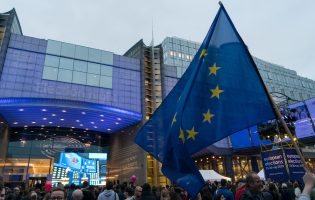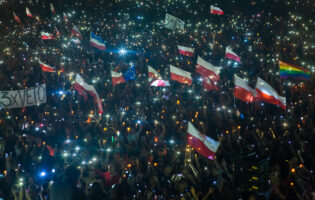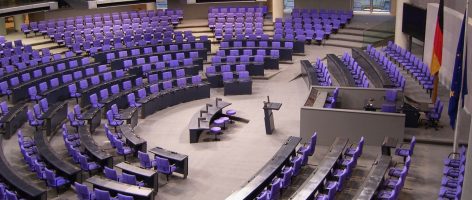A Culture of Decline?
On September 24, 2009, the American-German Institute (AGI) and the German Historical Institute (GHI) organized a panel discussion in Washington, D.C., on “A Culture in Decline: Politics, Economy, and Social Life in East Germany.” Following the discussion, the participants had the opportunity to view artist Tom Block’s work “Broken Berlin Wall,” which is currently on display at AGI. The Institute is grateful to the Elfriede Dräger Memorial Foundation for its generous support of this event.
The panel discussion brought together policy experts from both sides of the Atlantic to discuss the current political and economic challenges facing eastern Germany. Most panelists argued that despite suffering under the planned economy imposed by the Soviet Union, a modernized infrastructure and flexible labor market have increased productivity levels in eastern Germany close to those observed in the west. On the other hand, some contended that forty years of socialism has had lasting effects on the eastern German political and economic system and it is unclear whether it will be able to curb issues such as emigration, minimal foreign direct investment, and limited contributions toward research and development in the private sector.
The debate focused primarily on structural changes endured in the eastern German economy both during the German Democratic Republic (GDR) and after reunification. The discussion then moved to the topic of whether the socialist “cradle to the grave” system has created an eastern German “mindset” or social norms by which preferences are formed and implemented. Lastly, the panel agreed that eastern Germany still suffers from a path dependency problem as it continues to break free from its past in the GDR; however, an economic convergence with western Germany may soon be on the horizon.
The discussion centered largely on the GDR’s economic rise in the 1960s and its subsequent fall in the 1970s and 1980s. The main question to be answered was whether eastern Germany’s socialist past would dictate its economic future. One panelist argued that the GDR’s economy was considered the tenth largest in the world; however, the nationalization of most industries in 1971 destroyed the “entrepreneurial spirit” of the country and led to its decline in the 1980s. Waste became a significant issue and productivity slowed to an abrupt halt throughout the GDR. East Germans were forced to live off the remaining capital stock and saw the middle class virtually disappear. The government took part in an extensive “social engineering” campaign in order to get the economy back on track and while enterprises were forced to maintain full employment, the saturation of labor failed to prevent economic stagnation in the GDR.
The panelists all agreed that the structural changes experienced under Soviet influence have had lasting effects on the ground, but these can and will decrease over time. The dismantling of industry by the Soviets, debilitated infrastructure, and concentration of low productivity sectors throughout the GDR are only a few reasons for why eastern Germany has fared worse than its western counterpart. The panel also discussed how participation in the Eastern bloc would lead to a divergence in preferences and work ethic between East and West Germany. Some argued that the willingness of east Germans to work longer hours for less pay, along with reunification, has helped eastern Germany achieve economic growth in the late 1990s and beyond.
The next section of the discussion moved from life under the GDR to economic progress after reunification. One speaker highlighted both the advantages and disadvantages faced by eastern Germany as a result of its exposure to global competition and its transition to a market-based economy. The general consensus was such that an absence of labor laws and unions in the east allowed for a more flexible labor market which could not be matched in the Federal Republic of Germany (FRG). The new states have since become “models of flexibility” for old states, undermining the “permanent effect” theory that ponders whether economic parity can ever be achieved between east and west. For example, during the most recent economic crisis, the east shed roughly 10,000 jobs whereas the west suffered a drastic loss of almost 300,000. One panelist dissented by suggesting both the east and the west were equally inflexible, however the west suffered more due to stricter laws already in place. On another note, after the unification process took effect, the FRG invested heavily in infrastructure in the east and was able to build a modern communications and transport network from the ground up. As a result, these modernization efforts are far more advanced than those in western Germany.
Although the economic forecast in eastern Germany looks promising, it still suffers from the lingering remnants of the former GDR. For instance, the panel argued that the east continues to experience a “brain drain” as young, highly educated entrepreneurers prefer life in the west where wages are higher and business opportunities are more prevalent. Although the United States did much to encourage foreign investment in the east after the fall of the Berlin Wall, company headquarters were already based in the west, making it difficult for them to take advantage of cheaper labor. While the manufacturing industry is experiencing steady growth of 9 percent a year, the gross domestic product is not increasing because the sector itself is shrinking. Finally, research and development in the private sector is significantly greater in the west, making it difficult for the east to compete and boost wage and productivity levels.
That being said, another speaker pointed out that foreign direct investment is on the rise in the Länder of Thuringia and Saxony. Moreover, the establishment of serious highly technical universities will only bolster economic growth in the east. In conclusion, the panel had high hopes the east will continue to build upon its historic strengths and shed its socialist past in order to adapt and achieve economic convergence with the west.
The Exhibition:
After the discussion, we welcomed guests to view artist Tom Block’s work “Broken Berlin Wall,” which is currently on display at AGI. The painting honors how walls are built and then crumble. Mr. Block has scattered pieces of the 72′ long painting throughout the offices of AGI to not only honor the reunification of Germany, but also the necessity to examine our own interior walls – and to not be fooled by the perceived beauty on the one side, which can hide a very different, and starker reality on the other.
Tom Block is an artist, writer and activist best known for his work that delves into the search for spiritual meaning in the contemporary era. His art has been exhibited in galleries and museums throughout the United States and Europe. For pictures of Mr. Block’s artwork at AGI, please click here.







